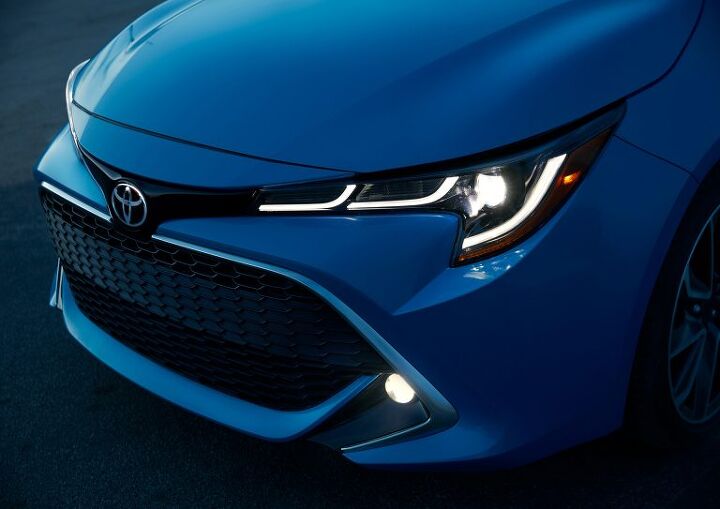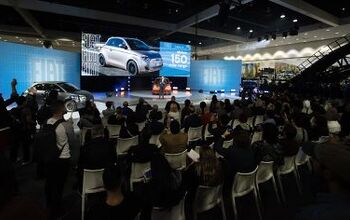Toyota Promises Solid-State Batteries By 2025

While electrification has felt like the only thing automakers are willing to talk about anymore, CES 2022 provided yet another opportunity to see which companies are willing to make the biggest promises when pitted against each other. This encouraged plenty of manufacturers to issue reminders of their existing EV timetables, though we’d be lying if we expected any company to adhere to them all that closely.
Then there’s Toyota. Despite being the largest automaker on the planet by volume, the Japanese company is famous for hedging its bets and not being all that secretive about it. When other manufacturers were vowing swift electrification at all costs, Toyota said they would need to continue producing hybrids if they were to realistically serve the public. But the business is still developing battery tech, with a vested interest in selling it off to rival manufacturers who are more willing to run with BEVs exclusively. It’s also been developing solid-state batteries, which it has confirmed are on track for delivery by 2025.
During CES, Toyota announced it was planning on launching a passenger vehicle equipped with solid-state hardware. We’d heard about it before. The automaker announced a bipolar nickel-metal hydride battery would eventually be thrown into the Japanese-market Toyota Aqua (our Prius C) in the fall. Critics have argued that the in-development power cell relies too much on old technology, while the manufacturer has asserted that incremental improvements toward existing technologies simply make more sense.
The issue came up again during a discussion between the head of the Toyota Research Institute, Gill Pratt, and Autoline at CES 2022. Pratt indicated that the brand was still on schedule to release its first solid-state units prior to 2025, noting that the first examples would likely be going into a hybrid vehicle.
Toyota believes that sticking with internal combustion will make it easier to commercialize solid-state batteries and keep vehicles at a price point that’s competitive with all-electric vehicles. While this seemed to surprise many in the automotive press, I’ve heard more engineers from Toyota openly discuss the present-day limitations of battery-electric vehicles than any other manufacturer. They’re always concerned with energy density, the additional weight of battery packs, and how that might affect pricing and range. The company is also famously risk-averse, placing a strong emphasis on long-term durability, and that’s something Pratt was inclined to address during the interview.
He said that Toyota’s President, Akio Toyota, opted to leak far more details about its electrification goals ahead of the holidays than anybody really expected. But claims that the automaker was going to be focused exclusively on electrification lacked context. Toyota had indeed kept pace to develop a working solid-state prototype in 2021 and still plans to sell an automobile equipped with a production unit within the next three years. However, it would be a hybrid, not a pure electric vehicle.
“We’re going to start by using them in hybrid vehicles and the reason for that is because the battery pack will be smaller, so it’s a little less sensitive to costs,” Pratt explained. “But also the amount of cycling that goes on in a hybrid vehicle for the battery is actually a tougher test. So we want to start by putting them in vehicles where we believe they’ll there both the most well suited, in terms of lifetime, but also will exercise them sufficiently — so that as costs continue to go down we can roll them out in the future in BEVs.”
“One of the issues people have talked a lot about in terms of BEVs not being a quite a drop-in substitute for a gasoline powered car is refueling time. One of the great hopes of solid-state batteries is not only greater energy density and, potentially in the future, longer lifetime and lower cost. But also the potential to charge them must faster.”
Pratt continued by outlining how modern charging stations aren’t yet able to output the kind of energy that would make any purely electric vehicle (solid-state or otherwise) capable of recouping lost energy as fast as one could fill up the tank of an internal combustion vehicle. That is also playing a factor in Toyota’s decision to continue running with a mix of powertrains, rather than tossing all of its eggs in one basket.
Pratt said that could change, however, as technologies advance and government influence helps improve national charging networks. When asked if it was possible to get to a point where battery-electric cars could recoup full charges in around five minutes under idyllic circumstances, the top dog at Toyota’s Research Institute said he hoped so someday.
“But I think it’s going to take more R&D to get there,” Pratt said.
[Image: Toyota]

A staunch consumer advocate tracking industry trends and regulation. Before joining TTAC, Matt spent a decade working for marketing and research firms based in NYC. Clients included several of the world’s largest automakers, global tire brands, and aftermarket part suppliers. Dissatisfied with the corporate world and resentful of having to wear suits everyday, he pivoted to writing about cars. Since then, that man has become an ardent supporter of the right-to-repair movement, been interviewed on the auto industry by national radio broadcasts, driven more rental cars than anyone ever should, participated in amateur rallying events, and received the requisite minimum training as sanctioned by the SCCA. Handy with a wrench, Matt grew up surrounded by Detroit auto workers and managed to get a pizza delivery job before he was legally eligible. He later found himself driving box trucks through Manhattan, guaranteeing future sympathy for actual truckers. He continues to conduct research pertaining to the automotive sector as an independent contractor and has since moved back to his native Michigan, closer to where the cars are born. A contrarian, Matt claims to prefer understeer — stating that front and all-wheel drive vehicles cater best to his driving style.
More by Matt Posky
Latest Car Reviews
Read moreLatest Product Reviews
Read moreRecent Comments
- Jeff Self driving cars are not ready for prime time.
- Lichtronamo Watch as the non-us based automakers shift more production to Mexico in the future.
- 28-Cars-Later " Electrek recently dug around in Tesla’s online parts catalog and found that the windshield costs a whopping $1,900 to replace.To be fair, that’s around what a Mercedes S-Class or Rivian windshield costs, but the Tesla’s glass is unique because of its shape. It’s also worth noting that most insurance plans have glass replacement options that can make the repair a low- or zero-cost issue. "Now I understand why my insurance is so high despite no claims for years and about 7,500 annual miles between three cars.
- AMcA My theory is that that when the Big 3 gave away the store to the UAW in the last contract, there was a side deal in which the UAW promised to go after the non-organized transplant plants. Even the UAW understands that if the wage differential gets too high it's gonna kill the golden goose.
- MKizzy Why else does range matter? Because in the EV advocate's dream scenario of a post-ICE future, the average multi-car household will find itself with more EVs in their garages and driveways than places to plug them in or the capacity to charge then all at once without significant electrical upgrades. Unless each vehicle has enough range to allow for multiple days without plugging in, fighting over charging access in multi-EV households will be right up there with finances for causes of domestic strife.


































Comments
Join the conversation
So if we can increase ev production by about 20 times the current pace, and if ev's can somehow become affordable compered to similar ICE vehicles without taxpayer subsidies, and if nuclear power plants can be built in every state and region to supply emissions free power them.... all we have to do is figure out a way do double the maintenance budget for every road in America to repair the damage caused by cars and trucks carrying any extra 1 to 3 thousand pounds in weight everywhere they go. Or we could just force the proles to walk and ride bikes and have cars for the wealthy only. Either way should work.
I predict that Toyota will win (as they always do). They know what consumers want before the consumer actually does, see Camry , Rav4 /Highlander. In this instance though they don't need a crystal ball though. Most surveyed adults indicated they would buy a hybrid as their next commuter car. In fact , even gear headed Car and Driver polled respondents chose a hybrid. As long as Toyota still builds Supras and GRs- I'd drive a hybrid AWD Camry daily and a GR. If our 18 Limited Prem . Sienna were totaled today I'd probably go ahead and buy a new Sienna given what the replacement cost would be , but I'd miss the big v6 for sure, but a Hybrid would make more sense.